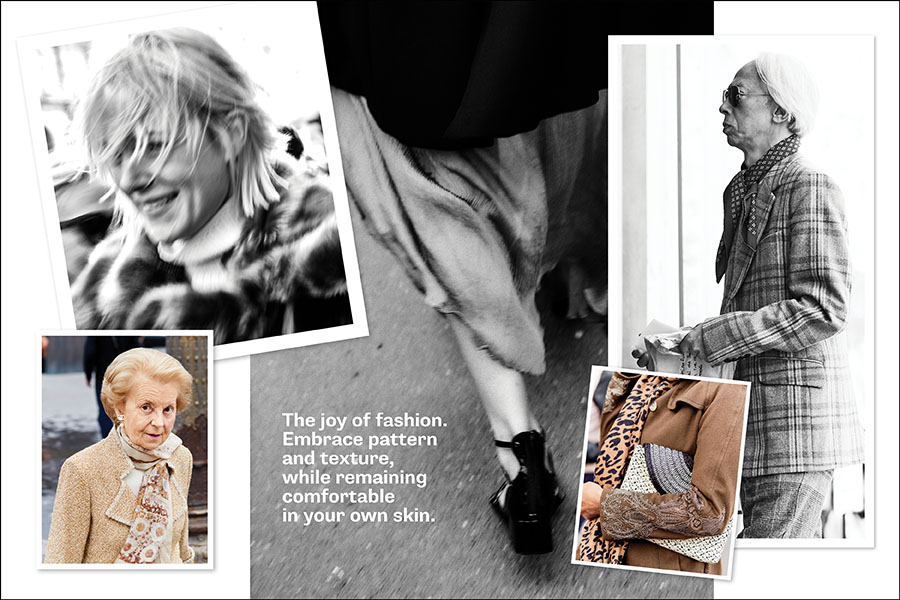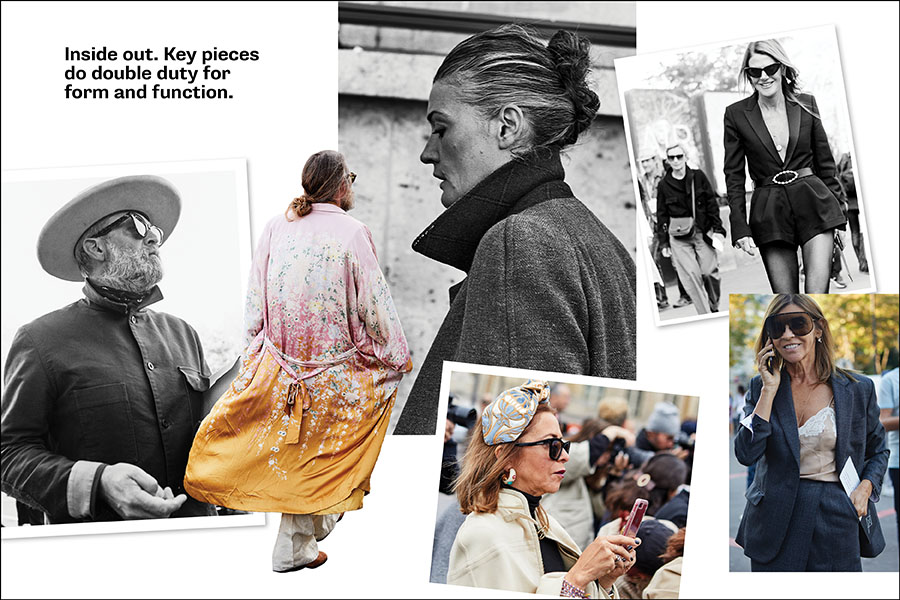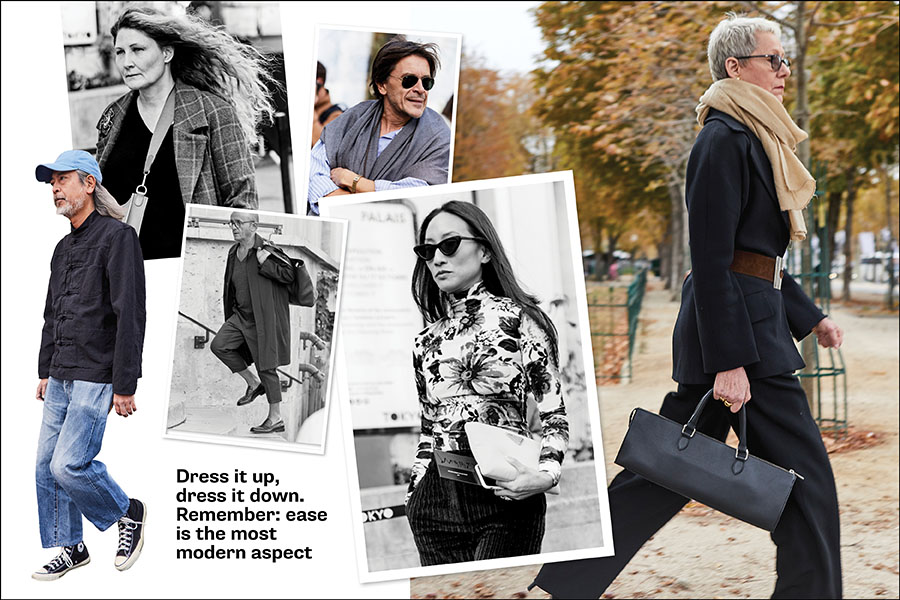No Sweats: Why Dressing Up is Good For You, Plus Inspiration to Elevate Your Pandemic Style

Stuck in a pandemic fashion rut? It turns out ditching the sweats and pyjamas and getting dressed up again may actually be good for our well-being. Photo: Ted Belton
Easy jokes about track pants and breakfast dessert have become cloying. We have entered the long-haul part of the pandemic, and it is time to put some snappy back in our routines, and that means getting properly dressed again.
There is plenty of good science to show us that continuing to get dressed each day bolsters our mental health, our self-esteem and motivation. A good outfit can win the war: there is a reason military uniforms with their stiffened creases and polished shoes matter. In times of chaos, we must take order any damn way we can get it.
“I can’t stress this enough,” says fashion psychologist Shakaila Forbes-Bell, writing about the sartorial challenges of the pandemic on her website fashionispsychology.com. “Giving up the glam life is not recommended.”
Forbes-Bell, who was one of the first people to earn a master’s in fashion psychology at the University of the Arts London, London College of Fashion, is part of a wave of social media-savvy academics in the relatively new field of analyzing (and popularizing) why what we wear matters.
The pandemic has also caused a number of Canadians to retire early — whether they want to or not. Such an abrupt ending can make both lockdown and the transition out of working life much harder, says Caroline Paradis of VoxCorvi, a Montreal-based retirement coach. “You are deciding what you want to do with your life, the same way you did back when you were a teenager. It is a big decision.” What is going on right now is kind of a laboratory, she says. “We are all looking at ourselves, each individual, in this strange limbo context with variables changing. The coach in me thinks it is an opportunity to learn about yourself. Say, for instance, did you really used to like wearing a suit to work? What does that tell you about what you enjoy in your work day to consider moving forward?” Keeping up appearances is crucial, Paradis says. “Taking pride in grooming is a way to bridge the change: loss of identity is the big topic in retirement coaching.”
Keep as many of your routines as possible is the advice Jennifer Rovet would give to unplanned retirees. A retirement coach who runs RetireReadyCanada.com, she says, “If you worked out, keep working out, get outside for a walk, talk to friends and family. And for sure don’t let yourself go: it has a direct impact on your mental health, staying in bed all day.” Retirement, she says, brings all kinds of emotional stages to even the most forward-planning individuals: shock, anger, sadness, denial — the same stages of grief to acceptance for all major life transitions. Dressing for success right now means just getting dressed!
For those of us that are still working, our comfy WFH outfits may be starting to gross us out (and the few humans we are allowed to be around), says Forbes-Bell. In her role as consumer retail expert with Afterpay (the online shopping instalment financing company — told you this field was both hot and hip), she offered evidence to back up how dressing up again can make us feel better.

“Switching up your style has a proven positive effect on mental well-being,” she says. “Surveys have shown that when people are encouraged to make even small changes to their style of dress, their anxiety and stress levels drop by more than 70 per cent.” This statistic comes from a study by another leading fashion psychologist, Karen Pine, a psychology professor at the University of Hertfordshire who wrote a book called Mind What You Wear. Pine tracks data from her online social movement Do Something Different, which in turn tests out her theories about how conscious dressing – defined as making an effort and experimenting with fashion — can increase well-being, decrease stress and reduce anxiety.
Consumers seem to sense this instinctively. Wardrobes are looking up, polish-wise. In September, Afterpay, which tracks the shopping habits of its 10 million international clients, noticed a huge increase in purchases of denim. Beauty purchases were also up dramatically compared to this time last year. Denim, which was once considered casual, is now a certifiable solid step up from pyjamas, Forbes-Bell says. “By providing slightly more comfort than a pantsuit and being a welcome change from those loungewear essentials, jeans can support consumers to maintain productivity as they tackle this new normal.”
Hopeful words. For the most part, the state of the fashion industry is in meltdown. McKinsey & Co., a global consulting company based in New York with offices in 65 countries, releases a fashion report every year. In December, along with the U.K. publication Business of Fashion, McKinsey released its State of Fashion 2021 report on what it saw coming this year for the global fashion and accessories industry, valued at US$2.5 trillion dollars. First of all, profits ended up being down an unthinkable 93 per cent last year. Not only has consumer spending tanked, but supply chains have been disrupted, and the whole system of fashion weeks hangs in the balance. But the report concludes on a bright note, that the industry has scrambled to rethink its purpose in our lives. “While the crisis has visited a devastating impact on businesses and jobs, it may also have accelerated responses that can lead to positive outcomes.”
Indeed, many fashion companies have taken time during the crisis to reshape their business models, streamline their operations, and sharpen their customer propositions. In other words, brands bent over backwards to meet our needs online, and respond faster to our shifting desires.

Historically, though, fashion eventually responds to tragedy and disorder with a big boomerang effect: the lush silks, satins, velvets and brocades of the Renaissance flourished after the bubonic plague ended. More recently, the end of the First World War and the Spanish flu ushered in the exuberant wardrobes of the Roaring Twenties. The extravagant, sculptural New Look rose out of the privations of the Second World War. There were two oil crises in the ’70s that upended the economy and consumer confidence: the first (’73/’74) preceded the celebratory outpouring of disco slink and sequins (Saturday Night Fever was released in ’77), the second (’79/’80) was followed by the shoulder-padded power suits of the Reagan years and the glitzy Nolan Miller gowns of Dynasty.
Clothing is also the most immediate and effective way of defining and sharing our identity with others. We have not been dressing up because we can’t go out and be around other people. To get ourselves out of this rut, now is the time to either double down on our existing image or create an entirely new one from the ashes. Toronto celebrity stylist Talia Brown Thall, who dressed Meghan Markle when she was working on Suits in the city, says that older celebrities are the ones who are really leading the way (online, which is really the only fashion platform available right now). “Diane Keaton is a bright light. She posts better than a teen and knows how to keep people engaged. What she is doing is her twist on classic chic: jeans, little hats, trench coats, modern yet still elegant.” And not to mention a throwback to the 75-year-old’s iconic Annie Hall style.
Attitude is important too, when making an impression online. “Goldie Hawn may still be wearing leggings, but she always has. That is her look,” says Brown Thall of the 75-year-old star. “She knows her style. But it is her high-level energy – she is dancing around her house – that is inspiring.” The stylist also points to J.Lo as a pandemic panacea at age 51. “She is not giving up. She gets dressed, does her makeup, looks put together every single day.”
Freed from publicity junkets and red carpets, celebrities are making their own art with fashion and image. “And the men, in particular, are killing it,” adds Brown Thall. “Stanley Tucci mixing cocktails looking soigné. That is what we will remember from 2020. And Rob Lowe — you see his own kids in on the joke when they mock him. Imagine having a dad who is that hot?” At age 60 and 56, respectively, these guys are unlikely pandemic heartthrobs.
Inspiration can come in small decisions. Brown Thall’s biggest piece of advice for her clients right now is to lean into colour. “You don’t want to be the one on the Zoom call or the Instagram grid wearing funereal black right now. We subconsciously register bright colour as cheerful and optimistic. And attention to detail counts more right now: the act of grooming symbolically gives out the message things are going to be okay.” Act like a winner because we, as humans, are attracted to winners.

This is a great opportunity for both individuals and the fashion system as a whole to change our relationship with shopping. The old “seasons,” where designers presented ever-increasing numbers of collections a half-year or more ahead of when we will actually be wearing the clothes, have been under attack as impractical and irrelevant. It just all became too much stuff, which no longer feels modern given we have been wearing one T-shirt on repeat for months. Now that we take in style cues in so many different formats, we don’t care about manufactured trends any longer. So much time on our own means we are collectively increasing our desire for individuality and custom style. There is no pack to follow right now, no Joneses to keep up with. Plus we don’t want to be adding to the vast quantities of landfill that resulted from the instant-gratification trigger we developed from our thrall with cheap fast-fashion thrills.
The fashion industry needed to change anyway. Demands for transparency and action around sustainability and social justice issues throughout the supply chain have been heard. Consumers yearn for luxury but not the logo à gogo brashness of the past. As in the aftermath of the 2008 financial crisis, the push is for secret luxury, quality over quantity. We are yearning for security and permanence and continuity, and we can manifest that in purchasing good pieces that last.
So let’s rise to this occasion and perk up ourselves and our Zoom co-workers and our social media contacts. Someday, hopefully soon, we will look with great revulsion at our drawers of tatty leggings and holey cardigans and say: Basta! In that moment, we will discover our inner stylist and get up every morning and get dressed and move into the future with some resolve in our spines and some starch in our shirts. Cheers to our coming reunification with our own closets.
A version of this article appeared in the Feb/March 2021 issue with the headline “No Sweat(s),” p. 74.
RELATED:
Golden Globes Fashion: From Designer Duds to COVID Casual, Our Favourite (And Least Favourite) Looks